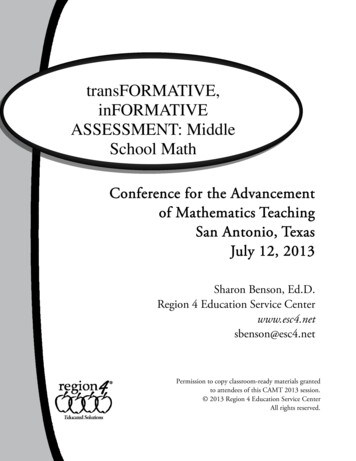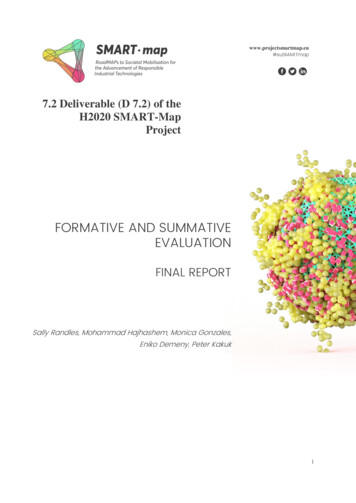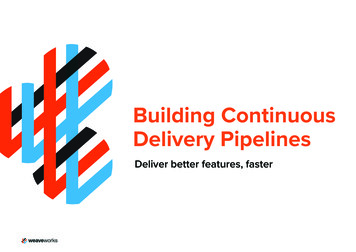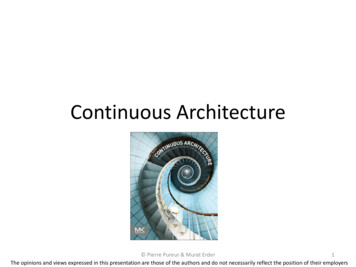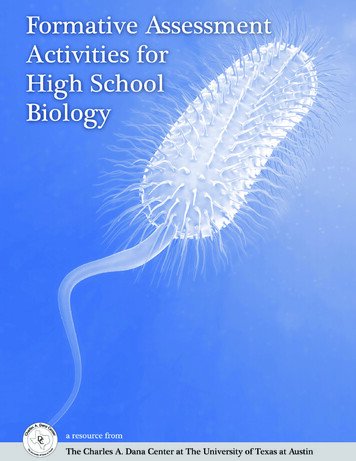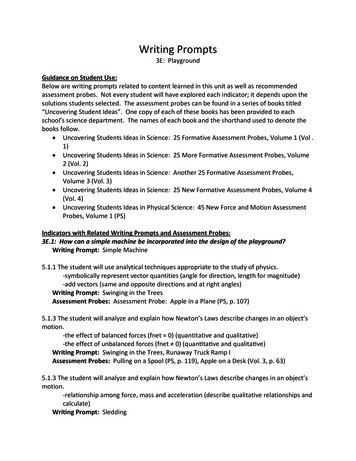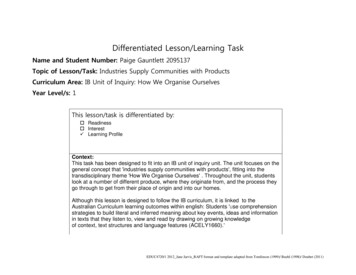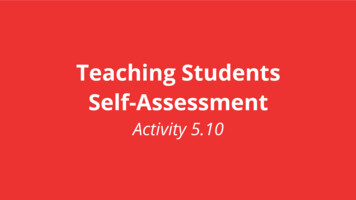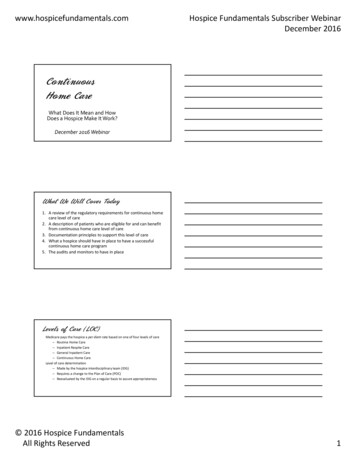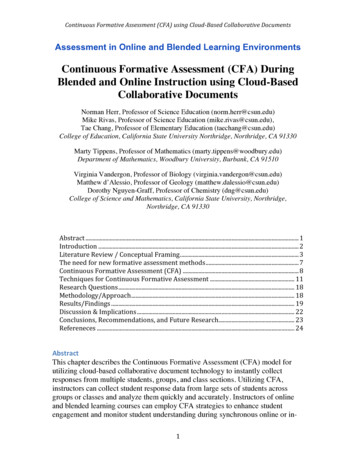
Transcription
ContinuousFormativeAssessment(CFA)usingCloud- ‐BasedCollaborativeDocumentsAssessment in Online and Blended Learning EnvironmentsContinuous Formative Assessment (CFA) DuringBlended and Online Instruction using Cloud-BasedCollaborative DocumentsNorman Herr, Professor of Science Education (norm.herr@csun.edu)Mike Rivas, Professor of Science Education (mike.rivas@csun.edu),Tae Chang, Professor of Elementary Education (taechang@csun.edu)College of Education, California State University Northridge, Northridge, CA 91330Marty Tippens, Professor of Mathematics (marty.tippens@woodbury.edu)Department of Mathematics, Woodbury University, Burbank, CA 91510Virginia Vandergon, Professor of Biology (virginia.vandergon@csun.edu)Matthew d’Alessio, Professor of Geology (matthew.dalessio@csun.edu)Dorothy Nguyen-Graff, Professor of Chemistry (dng@csun.edu)College of Science and Mathematics, California State University, Northridge,Northridge, CA ns,andFutureResearch.23Refereneces.24AbstractThis chapter describes the Continuous Formative Assessment (CFA) model forutilizing cloud-based collaborative document technology to instantly collectresponses from multiple students, groups, and class sections. Utilizing CFA,instructors can collect student response data from large sets of students acrossgroups or classes and analyze them quickly and accurately. Instructors of onlineand blended learning courses can employ CFA strategies to enhance studentengagement and monitor student understanding during synchronous online or in1
ContinuousFormativeAssessment(CFA)usingCloud- ‐BasedCollaborativeDocumentsperson instruction. As instructors analyze student responses, instructionadjustments can be made to meet immediate student needs. This chapterintroduces specific instructional strategies that may be employed to increase theaccountability and involvement of students in online settings. Preliminary datasuggests that the CFA methodology promotes engagement, accountability, andunderstanding through formative assessment for both students and instructors.IntroductionBlended and online learning environments provide instructors with significantchallenges regarding the engagement and assessment of learners. How canteachers engage learners and assess their understanding in remote settings?Furthermore, how can instructors perform formative assessment to adjust theirinstruction to meet the immediate needs of distant learners? The ContinuousFormative Assessment (CFA) model helps teachers create an environment thatengages learners and provides opportunities for instructors to monitor studentprogress through continuous formative assessments so they can modify instructionto maximize learning in blended and online environments.Schools and universities have been encouraged to develop a “culture ofassessment” to provide evidence on the effectiveness of instructional programs(Weiner, 2009). Although the emphasis on assessment has produced a wealth ofliterature, legislation, initiatives, reforms, and professional development, the vastmajority has focused on assessment of learning (summative assessment) ratherthan assessment for learning (formative assessment). Formative assessment isgenerally defined as a process used by teachers that provides feedback by whichthey can adjust ongoing teaching and learning to improve achievement during theprocess of instruction (Popham, 2008). What makes formative assessment‘formative’ is that it is immediately used to make adjustments to instruction tomeet the needs of the learners during the construction of understanding (Shepard,2005).Formative assessment is not a new concept, and any teacher who adjusts his or herteaching during instruction on the basis of evidence of student understanding andperformance is employing formative assessment (Popham, 2008; Shepard, 2005).Traditional formative assessment techniques such as student questioning orquizzes are limited in how many students are assessed or can be difficult toanalyze during class. The challenge is even greater in online environments werethere is limited interaction with students. How does one accurately assess studentcomprehension and performance during a class session, particularly in blendedand online settings?A promising response to this question is found in new collaborative cloud-baseddocument technologies. Such technologies provide the opportunity to instantly2
ContinuousFormativeAssessment(CFA)usingCloud- ‐BasedCollaborativeDocumentscollect and analyze large sets of data from multiple students, groups and classsections with speed and accuracy, regardless of the physical location of students.The CFA instructional model employs these technologies to create environmentsthat mirror collaborative professional research communities in which colleaguesevaluate each other’s work and ideas on a continual basis. Similarly, teacherscreate blended and online classroom activities in which students analyze wholeclass data using collaborative cloud-based spreadsheets, documents, wikis andpresentations. These activities help students gain an understanding that thelearning enterprise requires collaboration, independent verification, and peerreview. This chapter will introduce a range of collaborative cloud-based activitiesthrough which educators can continuously monitor student ideas and adjust theirinstructional practice to enhance student learning.LiteratureReview/ConceptualFramingTo understand formative assessment and its role in online and blended instruction,it is helpful to contrast it with summative and interim assessments. Summativeassessments are generally “high-stakes” tests that are used to determine studentgrades and class-wide or school-wide performance. Summative assessments areused to measure mastery of predetermined content or standards and are thebackbone of accountability systems at all academic levels. Student grades, collegeadmission, scholarships, graduation, and school rankings are all determinedprimarily by summative assessments. Summative assessments play a critical rolein accountability systems and inform local, statewide, and national educationalpolicies (Perie, Gong, & Wurtzel, 2007).Although summative assessments are invaluable for accountability, they cannot beused to diagnose gaps between student knowledge and the intended curriculum ata time when instructional adjustments can be made to benefit student learning.Summative assessments inform stakeholders concerning what students did or didnot learn, but do not provide information that will change instruction to benefitcurrent students. Educators therefore employ interim assessments throughoutinstruction to provide such information. Interim assessments, also known asmedium cycle assessments, are administered throughout a course to provideinformation to diagnose problems and provide information on how instruction canbe changed to best meet student needs. Interim assessments take many forms,such as quizzes and reports, and may factor into final grades and school or systemassessments. Interim assessments provide students with practice for summativetests and provide teachers with information necessary to adjust future instruction(Perie et al., 2007; Pinchok & Brandt, 2009).Although summative and interim assessments provide invaluable information andhelp establish an environment of accountability, they do not provide instructors orstudents with the information necessary to improve teaching and learning during3
ContinuousFormativeAssessment(CFA)usingCloud- ‐BasedCollaborativeDocumentsthe actual instruction. By contrast, formative assessments are embedded ininstruction and are directly linked to teaching and learning as it occurs. Formativeassessments identify gaps in understanding and can be used by teachers andstudents to make adjustments to improve student learning as it occurs. Formativeassessments can be frequent and provide teachers and students with timelyfeedback on progress (Black & Wiliam, 1998; Black & Wiliam, 2009; Shepard,2005).There is much research to show that formative assessments can be used to improvestudent learning success. Meta-studies analyzing the findings of numerousinvestigators concluded that formative assessments provide “moments ofcontingency” (Black & Wiliam, 2009, p. 10), critical points where learningchanges direction depending on an assessment. Well-designed formativeassessments provide information to make instructional modifications in real-timeto address student needs (Black & Wiliam, 2009; Shepard, 2005). There arenumerous techniques that can be used for formative assessment including handraising (in response to specific questions), hand signals (to measure levels of selfreported understanding), choral responses (in which students are invited torespond simultaneously to teacher-posed questions), think-pair-share (in whichteachers assess student understanding as student groups share with the class),quick-writes (in which students make journal entries in response to specificprompts), exit cards (in which students submit questions or answers as they leaveclass), self-assessments (in which students check their own understanding byworking problems or answering questions in class) and quizzes (in which teacherspose questions to test student understanding) (Bernackic, Ducettee, Majerichb,Stulla, Varnumd, 2011; Fluckiger, Vigil, Pasco, & Danielson, 2010; Jahan, Shaikh,Norrish, Siddqi, & Qasim, 2013; Youssef, 2012). All of these techniques haveproven valuable in traditional classroom settings but many of these still do notprovide the instructor with an immediate assessment of student needs.For example, the instructor gathers cards and reads them after class or gradesquizzes after class.Formative assessments have been shown to be particularly valuable with lowerperforming students. Learning deficiencies can be identified early in the learningcycle, allowing instructors to make teaching modifications before lowerperforming students are left behind (Athanases & Achinstein, 2003). Numeroustextbook publishers produce online quizzes to provide students and instructorsimmediate feedback, and such products can be very effective in helping identifygaps in students’ understanding (Hoon, Chong & Ginti Ngah, 2010). Formativeassessment is an iterative “joint productive activity” in which students assembleand interpret knowledge and present their understanding to their teachers who thenadjust instruction to optimize learning. This process is repeated throughoutlearning units (Ash & Levitt, 2003).4
ContinuousFormativeAssessment(CFA)usingCloud- ‐BasedCollaborativeDocumentsBandura (1997) and Zimmerman (2002) suggested that formative assessmentspermit students to express themselves and develop a sense of self-efficacy, a keyrequirement for the development of autonomous learning strategies. Polanyi(1967) and Schön (1987) emphasized the formative and reflective purpose ofstudent discourse and encourage an open community of learners where ideas andopinions are exchanged so that students can co-construct their understanding. TheCFA model provides an environment where such discourse can take place, butunlike traditional instruction where certain students dominate and others arepassive, all students are on an equal footing since all have access to the samedocument for their contributions. A discussion of the underlying theories onwhich the CFA model is built as well as practical instruction for implementationand findings from ongoing research follows.Formative Assessment and TechnologyOnline education has grown dramatically in recent years and is expected tocontinue growing in the years to come. In his State of the Union address,President Obama suggested that technology will play an increasingly significantrole in America’s plan to increase the number college graduates while decreasingthe cost of education (Obama, 2010). The President encouraged the growth ofonline education to attract more students to college, particularly those frompopulations under-represented on traditional brick-and-mortar campuses (Sturgis,2012). The growth of online and blended education has been accompanied by agrowing concern regarding the quality of online education (Hirner & Kochtanek,2012). Although it is easy to see how formative and interim assessments can beused to measure student understanding in online and blended classes, it is moredifficult to see how formative assessments may be employed to directly informinstructional strategies and pacing.The first electronic solution to formative assessment was the audience responsesystem developed in the early 1970s (Simmons, 1988). William Simmons, anexecutive at IBM, reflected on the lack of productivity in corporate meetings.Only one person could talk at a time and each decision required a formal vote.Executives often did not speak their mind because of the desire for conformitywith the opinions of their superiors. Simmons worked with Theodore Gordon ofthe Futures Group to design and develop an electronic audience response system.Simmons applied this technology in corporate meetings and found he got not onlygreater engagement but also more honest feedback. Simmons found that he couldinstantly get information on the group’s true consensus (Simmons, 1988).Today there are many audience response systems, also called “student” or“classroom” response systems, in use in educational settings including dedicated“clickers”, computer software, and smart phone apps that aggregate student inputs(Kay & LeSage, 2009). Such systems track individual responses, display polling5
ContinuousFormativeAssessment(CFA)usingCloud- ‐BasedCollaborativeDocumentsresults, confirm understanding of key points, and gather data for reporting andanalysis. These hand-held dedicated systems allow students to input responses toquestions posed by their instructor. The instructor receives immediate statistics onstudent performance on true-false, multiple-choice and short-answer questions.Studies have shown improved student participation, attendance, and learning withthe use of student response systems (Beatty & Gerace, 2009; Bennett &Cunningham, 2009; Buchanan, 2001; Chevalier, 2013; Gok, 2011; Peat &Franklin, 2002). Such systems not only provide information for teachers, theyincrease accountability for students (Kaleta, 2007). Although student responsesystems have been shown to be a valuable formative assessment tool, currentsystems do not provide adequate means for free response questions. They havelimited input capabilities and cannot receive complex text, audio, video, or graphicresponses that can be used to assess higher levels of understanding. Some usesalso require assessments to be prepared in advance, limiting the ability of theteacher to make a spontaneous assessment.Most student response systems require instructors to create multiple choice andshort answer questions prior to class. Although such systems have the advantageof providing detailed and immediate statistics on student understanding, they failto give any insight into the thinking of the student and the reason for theirunderstanding. To circumvent the limitations of hand-held student responsesystems, researchers at Colorado School of Mines (CSM) developed free webbased software known as InkSurvey that enables students to use pen-based mobiletechnologies to respond to the open-format questions of their instructor withdiagrams, equations, graphs and proofs (Kowalski, 2013a). The instructorinstantly receives student responses and thereby gains real-time insight intostudent thinking and can immediately reinforce correct understandings and addressmisconceptions as they develop. InkSurvey has been used successfully in collegephysics and engineering classes with enrollments exceeding 60 students.Researchers determined that when interactive engineering computer simulationswere coupled with real-time formative assessment data collected with InkSurvey,students achieved large and statistically significant learning gains regardless oftheir learning styles (Kowalski, 2013a).The formative assessment techniques mentioned so far have been shown to beeffective in traditional face-to-face classrooms, but can they be used insynchronous or asynchronous online or blended classes? Indeed, many of thetechniques mentioned so far can be replicated using cloud-based collaborativeresources. Reviews of the literature show that interactive online formativeassessments can foster a learner-centered focus and enhanced learner engagement(Gikandi, 2011). Online feedback systems that are integrated into the student’sonline learning space have been shown to improve student engagement andperformance (Chen 2009; Hatziapostolou, 2010; van Gog 2010). Interactive6
ContinuousFormativeAssessment(CFA)usingCloud- ‐BasedCollaborativeDocumentscomputer-marked assignments and conventional tutor-marked assignments havebeen shown to help students keep up-to-date in their studies (Jordan, 2009).Others have experimented with social networking to promote peer-to-peercollaboration and formative assessment (Blue & Tirotta, 2011) and some haveshown that blogs can be used as a student-based formative assessment tool tocultivate reflective peer-to-peer learning (Olofsson, Lindberg, Hauge & Trond,2011). Others have shown that anonymous electronic feedback systems can bebeneficial in stimulating instructors to make changes to improve the delivery ofonline courses (Berridge, Penny & Wells, 2012). Collectively, such studies haveindicated that web-based formative feedback can be instrumental in improving thestudent learning As mentioned previously, schools and universities are encouraged to develop a“culture of assessment” to provide evidence on the effectiveness of instructionalprograms (Weiner, 2009). Summative assessments provide information after thefact. They tell you what students did or did not master, but they do not provide theinformation necessary to make changes in instructional or learning strategies whilelearning is occurring. Although summative assessments may provide powerfulincentives for student learning, they do not inform teaching while it is occurringand therefore do not allow instructors and students to alter their approaches tooptimize the learning environment. Many teachers agree that formativeassessment is very important, but traditional techniques provide incompletepictures of student understanding. For example, a “show of hands” only tells theinstructor the percentage of students who think they understand, and not thepercentage that truly understand nor the level of their understanding. Thoughmany of the existing technological solutions work well for pre-planned assessment,they do not fluidly allow instructors to create follow-up prompts in real-time thatmodify their instruction in response to student needs.Educators have grappled with this problem for many years and have adopted avariety of techniques in an attempt to perform continuous formative assessments.For example, in the “modeling method” of physics instruction student teamssummarize their models and evidence on a small whiteboard that is easilydisplayed to the entire class. The whiteboard serves as a focus for the team’sreport and ensuing class discussions. (Hestenes, 2010; Wells, Hestenes &Swachkhamer, 1995). While this approach has been used effectively it does notproduce a lasting record of student’s thinking that can be referred to later.Students’ work disappears as soon as the whiteboard is erased. One solution is tohave students put their response on paper to be turned in as in a quick write(Clidas, 2010; Rief, 2002) or in a notebook/journal that students maintain duringthe course (Roberson, 2010).Both of these produce a lasting record, but thelogistical challenges of assessing and maintaining them make it difficult for7
ContinuousFormativeAssessment(CFA)usingCloud- ‐BasedCollaborativeDocumentsteachers to use them effectively (Ruiz- ‐Primo, Li, Ayala & Shavelson, 2004).As we move to blended learning and synchronous online learning, whichcombines computer-mediated activities with traditional face-to-face classroommethods, we need to think of new ways to use the best of current assessment tools.These environments create a number of new possibilities for formative assessmentthat allow teachers to quickly see meaningful student responses and adjustteaching based on their needs. There is a need for techniques which providecontinuous formative assessment that can be used in traditional, blended andonline learning contexts.ContinuousFormativeAssessment(CFA)The authors have developed a teaching technique that employs synchronouscollaborative web-based documents to perform continuous, real-time formativeassessments of students’ understanding so that educators can adjust theirinstruction to address the immediate needs of their students regardless of whetherthey are in traditional or online settings. The CFA model has the potential toengage all learners all of the time as they provide feedback, data, quick-writes andanalyses in response to instructor prompts. Using this model, teachers have theopportunity to observe all student contributions as they are made.The CFA model has been made possible by the development of free collaborativeweb-based spreadsheets, documents, presentations, and drawings (Herr, Foley,Rivas, d’Alessio, Vandergon, Simla, Nguyen-Graff & Postma, 2012a,b; Herr &Rivas, 2010; Herr, Rivas, Foley, Vandergon & Simila, 2011a,b; Rivas & Herr,2010). Online tools like Google Documents or Windows Office Live allowteachers to develop online documents and share editing privileges with theirstudents. The shared documents provide a platform for formative assessment asboth the teacher and the student have immediate access to the documents. Forexample, in a blended classroom in which students have computers or tablets, or inan online synchronous lesson, teachers can use a shared online spreadsheet torecord students responses. Teachers enter student names in column one and pose aquestion in the header of column two (Figure 1). Students respond to the questionin the cell next to their name, providing the teacher with instant informationregarding current student understanding of the lesson. This process can berepeated throughout the class allowing teachers to assess their studentscontinuously. The spreadsheet becomes a lasting artifact of student thinking andcan be analyzed later or referred to by both the teacher and the students.Although many companies now offer online documents, Google offers the mostcomprehensive suite of free resources, and so we shall discuss their offerings inmore detail. In 2006 Google acquired Upstartle, the software company whichintroduced the first web-based word processor. In addition, Google acquired8
ContinuousFormativeAssessment(CFA)usingCloud- ‐BasedCollaborativeDocumentsrights to the first web-based spreadsheet from 2Web Technologies (Google PressCenter, 2006). In 2007, Google developed the first web-based presentationprogram (Bodis, 2007) and introduced all three as a free development suite knownas Google Drive . Any individual who opens a free Google account has anautomatic link to Google Drive (formerly called Google Docs ). Users candevelop documents, spreadsheets and presentations online using any modernbrowser, or can import them from a wide range of formats. Google documents areautomatically saved to Google servers whose actual location or name is not needed.These documents are described as being located “in the cloud.” As with relatedwiki technologies, a revision history is associated with each document so users canreview, revise and/or reverse editorial changes.Cloud-based documents allow for the type of collaboration and sharingenvironment for productive student learning communities (Falkner & Falkner,2012). Teachers and students can work on the same file as they co-author reports,creative writing and other document. As students collaborate, each can see whichrevisions have been made by their colleagues, and can reverse or restore changesby selecting options in the revision history. Rather than working on original filesand sending copies for peers to work on, all students work directly on the originalso there is no confusion about the current status of the document. Such web-baseddevelopment resources preclude the need for expensive software, since all oneneeds is a free downloadable web browser.Collaborative cloud-based document technology creates new opportunities forformative assessment involving laboratory science experiences. While idealscience laboratory experiences should help develop scientific reasoning and anunderstanding of the complexity and ambiguity of empirical work (NationalResearch Council, 2006), many laboratory experiences that students receive do notassist in the achievement of these goals. Web-based documents can provide anopportunity for students to understand the complex and collaborative nature ofempirical research as they collect and analyze data from multiple lab groups,classes, or schools (Herr et al., 2011a; Herr & Rivas, 2010). Data collection canbe simplified by survey tools, such as Google Forms , that link directly to onlineGoogle Spreadsheets . Teachers or students can develop forms online and theninvite students to input their findings. Spreadsheets are created from the data, withrecords (rows) representing the lab groups, and fields (columns) representinganswers to specific questions. Links to survey forms and their associatedspreadsheets can be provided by copying document addresses to email messages,blogs, newsgroups or websites. Students reply to the online forms, and togetherbuild a single spreadsheet file that is shared by all.Within moments, an entire class can input their data, generating a table with asmany records as there are laboratory groups, and as many fields as there are9
ContinuousFormativeAssessment(CFA)usingCloud- ‐BasedCollaborativeDocumentsquestions on the form. These data sets can be analyzed with built-in online toolsand “mashup gadgets” (web application hybrids), or downloaded to each group foranalysis with traditional tools such as Microsoft Excel . The instructor can easilyanalyze all contributions on a single screen, regardless of the physical location ofthe contributors. This provides the opportunity for formative feedback andpossibly peer feedback as the results are apparent to all. For example, an onlineinstructor can collect observational weather data from their students and thenanalyze it in light of weather station reports of temperature, pressure and dewpoint. As class is conducted in a medium such as Google Hangouts (a free videoconferencing) or Collaborate (Blackboard’s tool for synchronous onlineinstruction), both the instructor and all of the students can continuously monitor allstudent data which is plotted on a Google Spreadsheet. This monitoring allows anew level of formative assessment for data collection, as many errors can beidentified and corrected before it’s too late (d’Alessio & Lundquist, in press).Many classroom experiments call for the measurement or calculation of specificvalues, such as the density of water, the molar volume of a gas, the wavelength ofa laser’s light, or the percentage of root tip cells in mitosis. Students may noticethat their values differ from those of other lab teams and thereby gain anunderstanding of the value of descriptive statistical measures, such as mean andstandard deviation, when analyzing experimental data. As students graph classdata using web-based spreadsheet tools, they may note bell-shaped distributionsand gain a more intuitive understanding of the normal curve and basic descriptivestatistics. Bimodal distributions may indicate the use of two different techniqueswhile random distributions may indicate flaws in experimental design orimplementation. By analyzing class data sets, students learn the complexity of thenatural world and see the need for standardizing procedures and controlling forconfounding variables. Thus, collaborative web-based technologies can beemployed to provide continuous formative assessment of laboratory techniques(Herr et al., 2010a; Herr et al., 2010b). Many science educators shy away fromonline and blended learning environments because they believe that suchenvironments do not provide realistic laboratory experiences and lack thecommunity that is so important to sc
Based(Collaborative(Documents!! 3! collect and analyze large sets of data from multiple students, groups and class sections with speed and accuracy, regardless of the physical location of students. The CFA instructional model employs these technologies to create environments
